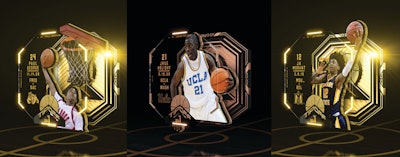
Non-fungible tokens, also known as NFTs, have emerged as a new, if nascent, digital collectible that both athletes and athletics programs are now leveraging as part of their marketing efforts. While many scoff at the millions of dollars being spent on supposedly “unique” digital items (some point to NFT digital art that can be duplicated and shared through a simple screenshot), NFTs are filling the void left by items such as paper tickets that have traditionally been issued as physical artifacts of events but have been largely discarded during the pandemic.
Rob Schneider, chief content, development and strategy officer at media and technology company Learfield, sees broad potential for NFTs, whether as stand-ins for physical tickets or as an NIL channel for athletes to leverage as they promote their personal brands through something akin to a trading card.
“We really took an approach with our partner RECUR that is trying to create actual utility and value for our university partners and their fans to help foster community and create other aspects of utility around ticketing, around special access to certain events and things of that nature,” Schneider says. “It’s really a more comprehensive strategy than just creating a collectible and putting it out in the wild.”
The pandemic acted as a catalyst for contactless payments and ticketing, meaning that fans were left without a hard copy of the ticket to frame as proof of their attendance at memorable games. (Ticket stubs from some premier games — Super Bowls and World Series — are collected and sell for thousands of dollars.)
“We don’t have a lot of data points right now with ticketing, but we do expect collectible commemorative tickets to be a viable NFT product, but largely driven by the fact that mobile ticketing has now taken over the market,” Schneider says. “I mean, over the course of the pandemic, we went from half a dozen schools that were doing mobile ticketing to now basically all schools do mobile ticketing. There just isn’t that collectible item you get when you pay for entry now. NFTs, I think, are a perfect way to fill that gap.”
Schneider says that Learfield sees fans taking to NFTs as they seek to mimic their physical world fandom in virtual digital environments (think video games and social media).
“It’s really about taking the things that you do in your everyday life and creating a digital equivalent,” Schneider says. “There’s a lot of gamification behind it and incentivizing folks to, if you will, fill out their locker room, or fill out their fan cave with all these elements. It’s the same way the biggest fans of the university have entire rooms in their houses dedicated to that fandom. Again, we’re trying to recreate that kind of expression of fandom, but just in a digital environment.”
Athletes have found NFTs to be an easy way to engage with their fans, as they don’t really have to do much to tap the medium’s potential as an NIL opportunity.
“It creates a revenue stream for those student-athletes, and obviously creates a better, more engaging product for the fans, as well,” Schneider says. “And it’s a great complement to all the other NIL activity that’s happening out there, because it’s scalable. It’s passive — the student-athletes sign up for it, but then it’s not as if they have to go out and do a branding campaign for a sponsor that distracts them from their schoolwork on top of their athletic responsibilities and everything else.”
Schneider says that some of the NFTs that RECUR has issued have sold out in a matter of minutes, and there’s evidence that the digital collectibles are catching on quickly with well-heeled fans. According to Stadium Talk, a David Beckham 2012-13 digital Rare Player Card sold for almost a half-million dollars through the digital marketplace OpenSea. Meanwhile, Deloitte Global predicts that NFTs for sports media will generate more than $2 billion in transactions in 2022, about double that of 2021. Deloitte expects four to five million sports fans worldwide will own an NFT sports collectible by the end of 2022.
































